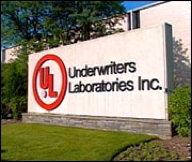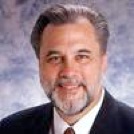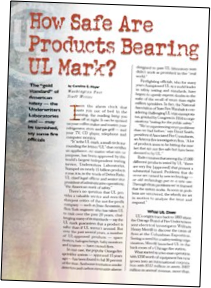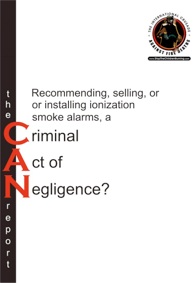







Underwriters Laboratories (UL) is the worlds largest independent product testing company.
The integrity of UL’s scientific testing of ionization smoke alarms has been under scrutiny
since UL said they would address their flawed testing in a 1978 Business Week Magazine
article. Twenty years after failing to fix their flawed testing, UL stated:
“All UL standards are developed to anticipate real-world events,
if we don’t anticipate everything . . . we change our standard.”
Chief Jay Fleming of the Boston Fire Department stated:
“...While an alarm may sound in UL Labs it may not go off in a home... “
UL is not a government agency - approximately 90% of its income is from its testing
services. UL has grown into, “... an international corporation with $512 million in
assets, $407 million in annual revenue, more than 5,200 employees and 13
laboratories worldwide.”
The UL Mark
How safe is UL’s ‘Safety Mark’


- - - - - - - - - - More Evidence - - - - - - - - - -
The S.A.F.E. Report
Closing the Deadly Loophole in the Australian Smoke Alarm Standard
Indiana’s, WTHR TV series -- Deadly Delay
Hagens Berman Sobol Shapiro -- Proposed Class Action Law Suit
Closing the Deadly Loophole in Australia’s Flawed Smoke Alarm Standard
Recommending, Selling or Installing Ionization Smoke Alarms, A Criminal Act of Negligence?








-
Steve Berman
-
Managing Partner, HBSS LLP
“Early warning is the key to surviving smoldering fires,
the deadliest kind of home fire.
“Ionization-only” smoke detectors ... are slow to warn
if they warn at all of smoldering fires,
which typically occur while occupants are sleeping.”
Hagens Berman Sobol Shapiro LLP
Proposed Class Action Law Suit
![Dr B. Don Russell
“After an hour, we had 50%
of the [ionization] smoke
detectors not sounding.”](ul2_files/shapeimage_16.png)









Adrian Butler, Chairman, The World Fire Safety Foundation, Gold Coast, Australia, July, 2010






UL’s Chief Legal Officer, Debra Rade stated UL had, “set the entire foundation for
product-safety certification.” Is UL in any way responsible for the standards testing of ionization smoke alarms in Australia given that Australia’s Smoke Alarm Standard has
been rewritten in acknowledgement of the fact that it is dangerously flawed?
“Don’t they have to please these
folks who pay them for the tests?”
Mark Chubb, South East Association of Fire Chiefs
UL’s World Headquarters
Chicago, Illinois, USA


Scroll to see all 5 pages



How Safe Are Products
Bearing the UL Mark?
Download: Here > > >



John Drengenburg
UL Consumer Affairs Manager
Caroline Meyer, Washington Post Consumer Reporter, Dec, 1999
As at the date of updating this webpage (April, 2010), despite assurances of doing
so for three decades, UL has failed to correct its flawed Smoke Alarm Standard (UL217).
UL’s ongoing negligence in failing to correct it’s flawed Smoke Alarm Standard and its
failure in it’s Duty of Care to warn the public about the known danger in ionization smoke
alarms will continue to lead to countless, needless fire deaths around the world.
Note: Read the ‘Special Duty of Care’ letter in The S.A.F.E. Report.

The CAN Report
Sent to UL by registered
mail in February 2007
Note:
The following article is a reprint from the Washington Post’s December 1999 issue:




























(c) Copyright 2010 The World Fire Safety Foundation | Last Updated: 25 March, 2011 | Privacy Policy | Disclaimer | Search WFSF site
For errors on, or suggestions for this ‘ul2’ webpage, contact the WFSF WebMaster | Supporters | About | Media